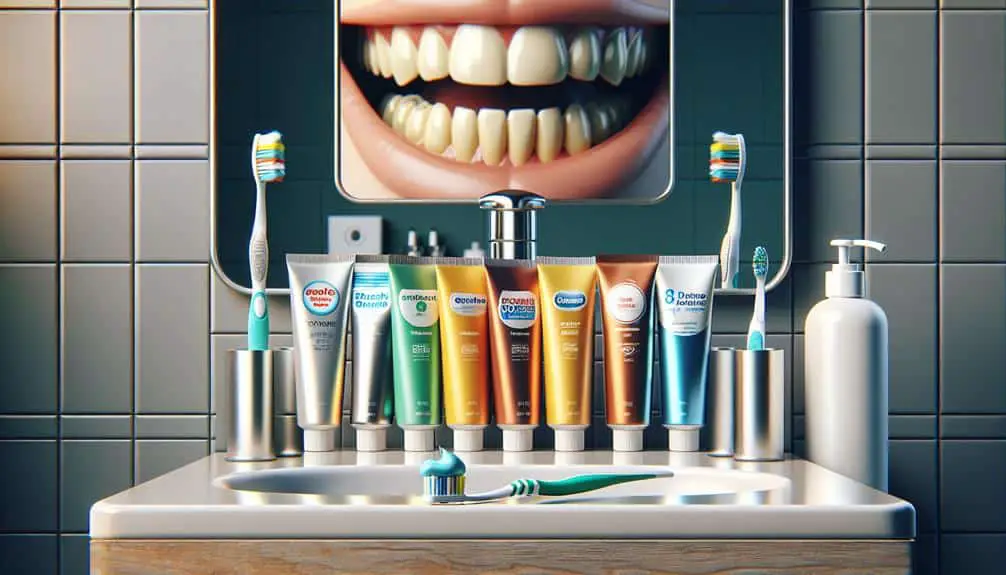To lessen sensitivity with yellow teeth whitening strips, choose ones designed for sensitive teeth to reduce discomfort. Select strips that suit your needs and fit well on your teeth. Before applying the strips, make sure your teeth are clean and consider using desensitizing toothpaste. Follow usage instructions carefully, apply the gel as directed, and take breaks between sessions to allow your teeth to recover. Avoid extreme temperatures and focus on post-treatment care to maintain results and oral health. Improve your whitening experience by following these steps to manage sensitivity effectively.
Key Points
- Choose whitening strips with sensitivity prevention formulations.
- Ensure teeth are clean and plaque-free before applying strips.
- Use desensitizing toothpaste before starting whitening treatment.
- Follow manufacturer's guidelines on wear duration to prevent sensitivity.
- Take breaks between whitening sessions to allow teeth to recover.
Understanding Yellow Teeth Sensitivity
If you've noticed yellow teeth sensitivity, it's important to understand the underlying causes to address it effectively. Sensitivity causes can stem from various factors such as enamel erosion, gum recession exposing the dentin, cavities, or even teeth grinding.
Enamel erosion, often caused by acidic foods or beverages, can lead to increased tooth sensitivity. Similarly, gum recession exposes the dentin, a sensitive layer beneath the enamel, making your teeth more prone to sensitivity. Cavities can also contribute to sensitivity as the decay reaches the nerves inside the tooth. Teeth grinding, known as bruxism, can wear down enamel and lead to sensitivity issues.
Prevention tips for yellow teeth sensitivity include using a soft-bristled toothbrush to prevent enamel wear, avoiding acidic foods and beverages, practicing good oral hygiene to prevent cavities, using a mouthguard if you grind your teeth, and seeking professional treatment for gum recession. Understanding these sensitivity causes and implementing prevention tips can help alleviate discomfort and maintain oral health.
Choosing the Right Whitening Strips
When selecting whitening strips, make sure to consider the specific needs and goals of your teeth. Strip selection is vital in achieving effective whitening results while preventing sensitivity. Different whitening strips come with varying concentrations of active ingredients, such as hydrogen peroxide or carbamide peroxide. If you have sensitive teeth, opt for whitening strips that are specifically formulated for sensitivity prevention. These strips usually contain ingredients like potassium nitrate or fluoride to help protect your teeth and gums during the whitening process.
Consider the duration of wear when choosing whitening strips. Some strips are designed to be worn for 30 minutes, while others may require an hour or more. It's important to follow the manufacturer's guidelines to avoid overuse, which can lead to increased sensitivity. Additionally, select whitening strips that fit comfortably on your teeth to ensure even application and maximum effectiveness.
Preparing for Whitening Treatment
Are you ready to enhance your smile through a whitening treatment? Before starting your whitening treatment with yellow teeth whitening strips, it's important to prepare properly to achieve the best results while minimizing the risk of sensitivity.
Here are some pre-treatment tips to help you get ready for the whitening process and prevent sensitivity issues.
Firstly, it's vital to make sure your teeth are clean and free of any plaque or debris. Brushing and flossing before applying the whitening strips will help the active ingredients make better contact with your teeth, leading to more effective whitening results.
Additionally, consider using a desensitizing toothpaste for a couple of weeks before starting the whitening treatment. This can help build up a protective barrier on your teeth and reduce the chances of experiencing sensitivity during or after the whitening process.
Lastly, if you have a history of tooth sensitivity, you may want to consult with your dentist before beginning the whitening treatment to discuss additional sensitivity prevention strategies tailored to your specific needs.
Managing Sensitivity During Whitening
To manage sensitivity during whitening, make sure you follow the recommended usage instructions provided with the yellow teeth whitening strips. Sensitivity prevention is essential in ensuring a comfortable whitening experience. Begin by applying a small amount of the whitening gel as directed, avoiding excess product that could seep onto sensitive areas. Remember that more gel doesn't equate to better results and can actually increase the likelihood of sensitivity. Additionally, consider using desensitizing toothpaste prior to treatment to help prepare your teeth for the whitening process.
Pain management techniques can also be beneficial in minimizing discomfort during whitening. If you experience sensitivity, consider taking breaks between whitening sessions to allow your teeth to recover. Using a toothbrush with soft bristles can help prevent further irritation to sensitive areas. Furthermore, avoiding extremely hot or cold foods and beverages during the whitening process can aid in managing sensitivity effectively. By implementing these strategies, you can navigate through the whitening process with greater ease and comfort.
Post-Treatment Sensitivity Care
After completing your yellow teeth whitening treatment, proper post-treatment sensitivity care is essential for maintaining comfort and ensuring the best results. Sensitivity prevention is vital during this phase. Avoid consuming extremely hot or cold foods and beverages, as they can exacerbate sensitivity. Opt for a soft-bristled toothbrush and gentle brushing techniques to prevent further irritation to the teeth and gums. Consider using a desensitizing toothpaste containing potassium nitrate to help alleviate any remaining sensitivity.
Treatment aftercare plays an important role in sensitivity management. Continue using any recommended post-whitening products, such as fluoride rinses or gels, to strengthen the enamel and reduce sensitivity. Attend follow-up appointments with your dentist to monitor your oral health and address any lingering sensitivity issues promptly. If sensitivity persists or worsens, consult your dental professional for further guidance. By following these post-treatment care tips diligently, you can minimize sensitivity and maintain a bright, healthy smile for longer.
Frequently Asked Questions
Can Yellow Teeth Whitening Strips Be Used on Sensitive Teeth Caused by Other Dental Issues, Such as Cavities or Gum Disease?
You should consult a dentist before using yellow teeth whitening strips on sensitive teeth caused by dental issues like cavities or gum disease. Professional advice is essential for effective sensitivity management and ensuring oral health during dental procedures.
Are There Any Long-Term Effects of Using Yellow Teeth Whitening Strips on Sensitive Teeth?
When considering the long-term effects of using yellow teeth whitening strips on sensitive teeth, it's important to prioritize sensitivity management. Achieving best whitening results should not compromise tooth health in the long run.
Can Yellow Teeth Whitening Strips Cause Discoloration or Damage to Dental Restorations Like Crowns or Veneers?
When using yellow teeth whitening strips, be cautious with dental veneers. These strips can potentially cause discoloration or damage to veneers and other dental restorations. Monitor any changes in color or integrity and consult your dentist promptly.
How Soon After Using Yellow Teeth Whitening Strips Can I Consume Food and Drinks That May Contribute to Sensitivity?
After using yellow teeth whitening strips, wait at least 30 minutes before consuming foods or drinks that may heighten sensitivity. To manage sensitivity effectively, restrict intake of acidic or cold items. Quick relief and pain prevention are essential.
Are There Any Specific Toothpastes or Mouthwashes That Can Help Alleviate Sensitivity Before or After Using Yellow Teeth Whitening Strips?
To prevent sensitivity, consider toothpaste options with potassium nitrate or stannous fluoride. Look for mouthwashes containing fluoride or potassium nitrate for additional relief. Incorporating these products into your oral care routine can help alleviate sensitivity before and after using yellow teeth whitening strips.
Conclusion
To sum up, yellow teeth sensitivity can be effectively reduced with the use of whitening strips. By selecting the appropriate strips, preparing adequately, and addressing sensitivity during treatment, you can achieve a brighter smile without discomfort.
Remember, just as a delicate flower needs gentle care to bloom, your teeth require gentle treatment to achieve a radiant, white appearance. Follow these tips to minimize sensitivity and enjoy a dazzling smile.



